Sustainable Enterprise: Monitoring Systems, Indicators, and Evaluation
VerifiedAdded on 2022/11/17
|19
|5270
|140
Report
AI Summary
This report provides an in-depth analysis of sustainable enterprise, emphasizing the crucial role of monitoring systems and indicators in evaluating performance and progress. The report defines monitoring as a continuous function involving data collection on specific indicators to assess the extent of progress and achievement of objectives. It explores the significance of M&E systems, detailing their structures, management processes, and the importance of stakeholder involvement. The report discusses various monitoring approaches, including Feedback Systems, Participatory Monitoring and Evaluations, and Logical Frameworks, highlighting their strengths and weaknesses. It then focuses on the SaveAct case study, an NGO dedicated to poverty reduction through savings and credit groups, financial education, and enterprise training. The report examines the indicators used to measure success within this enterprise, emphasizing the importance of specific, observable, and measurable factors. Overall, the report underscores the need for robust M&E systems and the development of clear indicators to ensure sustainable livelihoods and financial security for vulnerable groups.
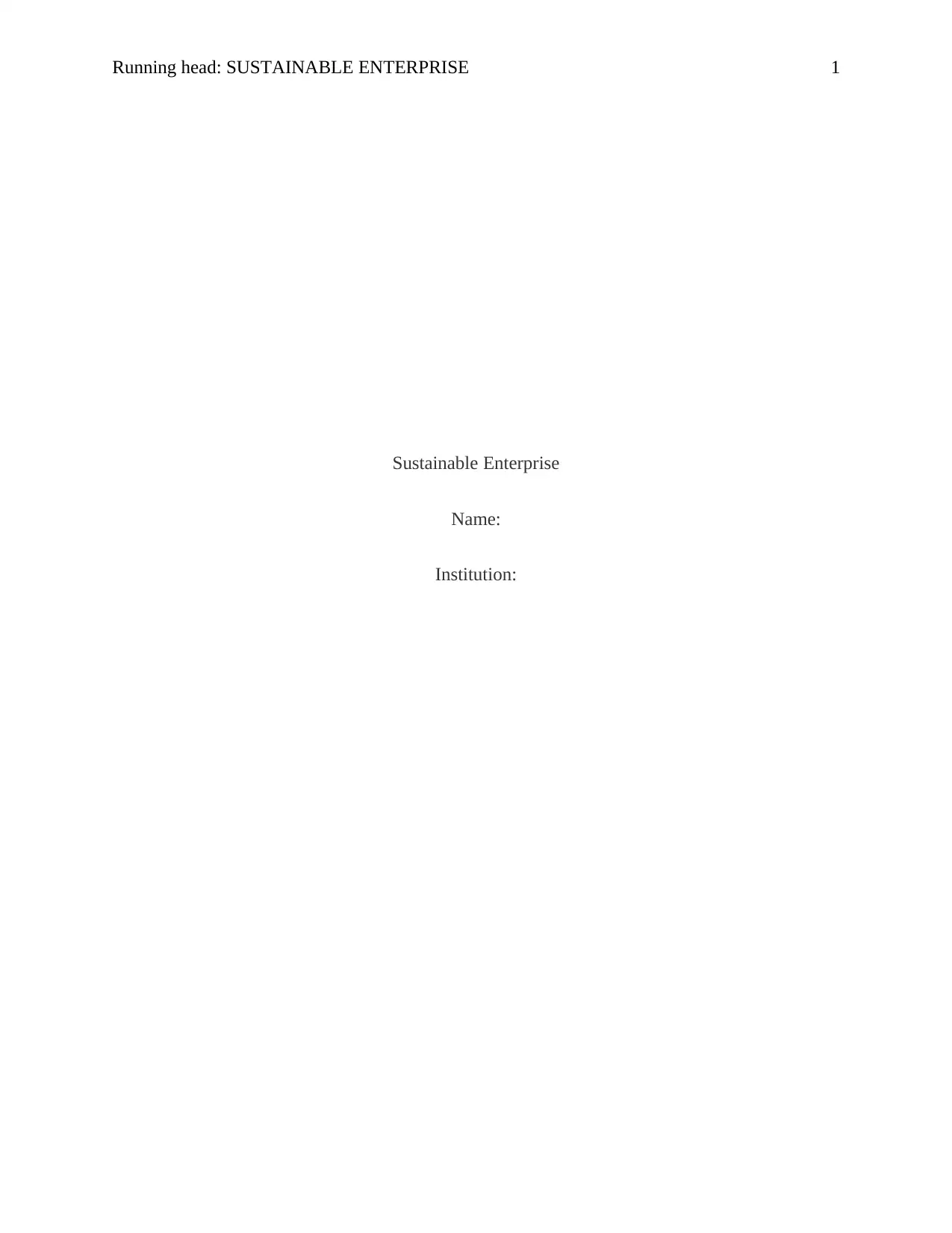
Running head: SUSTAINABLE ENTERPRISE 1
Sustainable Enterprise
Name:
Institution:
Sustainable Enterprise
Name:
Institution:
Paraphrase This Document
Need a fresh take? Get an instant paraphrase of this document with our AI Paraphraser
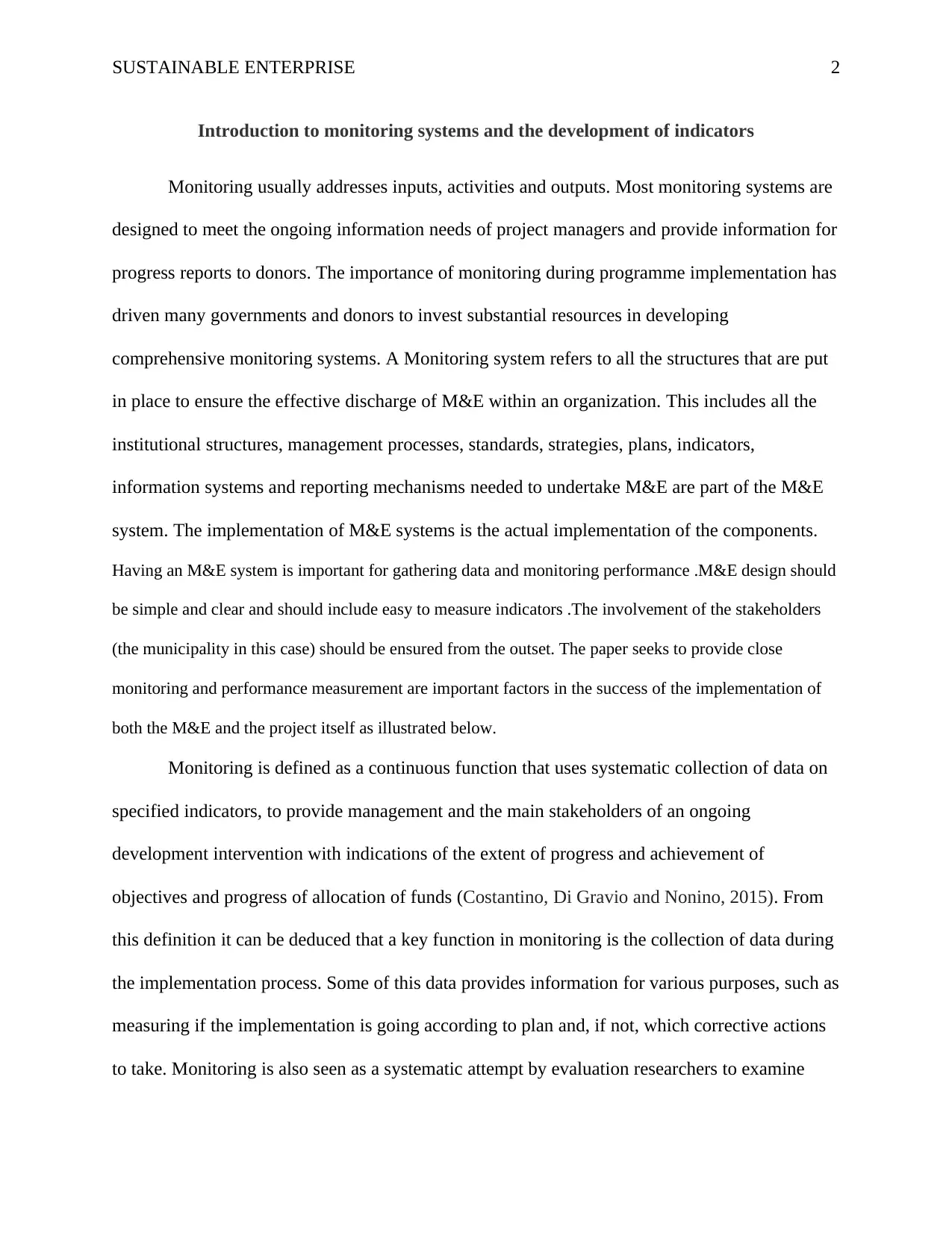
SUSTAINABLE ENTERPRISE 2
Introduction to monitoring systems and the development of indicators
Monitoring usually addresses inputs, activities and outputs. Most monitoring systems are
designed to meet the ongoing information needs of project managers and provide information for
progress reports to donors. The importance of monitoring during programme implementation has
driven many governments and donors to invest substantial resources in developing
comprehensive monitoring systems. A Monitoring system refers to all the structures that are put
in place to ensure the effective discharge of M&E within an organization. This includes all the
institutional structures, management processes, standards, strategies, plans, indicators,
information systems and reporting mechanisms needed to undertake M&E are part of the M&E
system. The implementation of M&E systems is the actual implementation of the components.
Having an M&E system is important for gathering data and monitoring performance .M&E design should
be simple and clear and should include easy to measure indicators .The involvement of the stakeholders
(the municipality in this case) should be ensured from the outset. The paper seeks to provide close
monitoring and performance measurement are important factors in the success of the implementation of
both the M&E and the project itself as illustrated below.
Monitoring is defined as a continuous function that uses systematic collection of data on
specified indicators, to provide management and the main stakeholders of an ongoing
development intervention with indications of the extent of progress and achievement of
objectives and progress of allocation of funds (Costantino, Di Gravio and Nonino, 2015). From
this definition it can be deduced that a key function in monitoring is the collection of data during
the implementation process. Some of this data provides information for various purposes, such as
measuring if the implementation is going according to plan and, if not, which corrective actions
to take. Monitoring is also seen as a systematic attempt by evaluation researchers to examine
Introduction to monitoring systems and the development of indicators
Monitoring usually addresses inputs, activities and outputs. Most monitoring systems are
designed to meet the ongoing information needs of project managers and provide information for
progress reports to donors. The importance of monitoring during programme implementation has
driven many governments and donors to invest substantial resources in developing
comprehensive monitoring systems. A Monitoring system refers to all the structures that are put
in place to ensure the effective discharge of M&E within an organization. This includes all the
institutional structures, management processes, standards, strategies, plans, indicators,
information systems and reporting mechanisms needed to undertake M&E are part of the M&E
system. The implementation of M&E systems is the actual implementation of the components.
Having an M&E system is important for gathering data and monitoring performance .M&E design should
be simple and clear and should include easy to measure indicators .The involvement of the stakeholders
(the municipality in this case) should be ensured from the outset. The paper seeks to provide close
monitoring and performance measurement are important factors in the success of the implementation of
both the M&E and the project itself as illustrated below.
Monitoring is defined as a continuous function that uses systematic collection of data on
specified indicators, to provide management and the main stakeholders of an ongoing
development intervention with indications of the extent of progress and achievement of
objectives and progress of allocation of funds (Costantino, Di Gravio and Nonino, 2015). From
this definition it can be deduced that a key function in monitoring is the collection of data during
the implementation process. Some of this data provides information for various purposes, such as
measuring if the implementation is going according to plan and, if not, which corrective actions
to take. Monitoring is also seen as a systematic attempt by evaluation researchers to examine
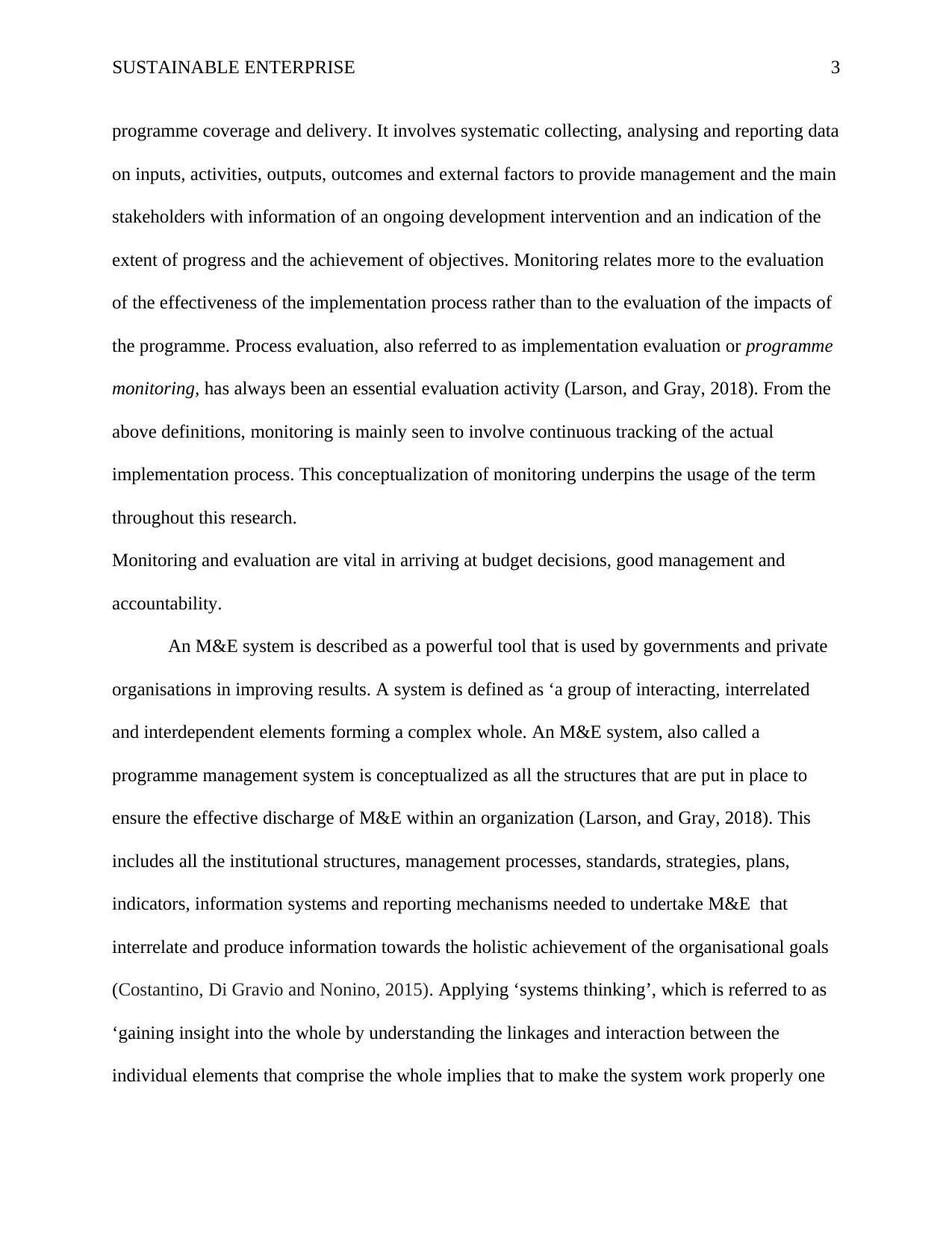
SUSTAINABLE ENTERPRISE 3
programme coverage and delivery. It involves systematic collecting, analysing and reporting data
on inputs, activities, outputs, outcomes and external factors to provide management and the main
stakeholders with information of an ongoing development intervention and an indication of the
extent of progress and the achievement of objectives. Monitoring relates more to the evaluation
of the effectiveness of the implementation process rather than to the evaluation of the impacts of
the programme. Process evaluation, also referred to as implementation evaluation or programme
monitoring, has always been an essential evaluation activity (Larson, and Gray, 2018). From the
above definitions, monitoring is mainly seen to involve continuous tracking of the actual
implementation process. This conceptualization of monitoring underpins the usage of the term
throughout this research.
Monitoring and evaluation are vital in arriving at budget decisions, good management and
accountability.
An M&E system is described as a powerful tool that is used by governments and private
organisations in improving results. A system is defined as ‘a group of interacting, interrelated
and interdependent elements forming a complex whole. An M&E system, also called a
programme management system is conceptualized as all the structures that are put in place to
ensure the effective discharge of M&E within an organization (Larson, and Gray, 2018). This
includes all the institutional structures, management processes, standards, strategies, plans,
indicators, information systems and reporting mechanisms needed to undertake M&E that
interrelate and produce information towards the holistic achievement of the organisational goals
(Costantino, Di Gravio and Nonino, 2015). Applying ‘systems thinking’, which is referred to as
‘gaining insight into the whole by understanding the linkages and interaction between the
individual elements that comprise the whole implies that to make the system work properly one
programme coverage and delivery. It involves systematic collecting, analysing and reporting data
on inputs, activities, outputs, outcomes and external factors to provide management and the main
stakeholders with information of an ongoing development intervention and an indication of the
extent of progress and the achievement of objectives. Monitoring relates more to the evaluation
of the effectiveness of the implementation process rather than to the evaluation of the impacts of
the programme. Process evaluation, also referred to as implementation evaluation or programme
monitoring, has always been an essential evaluation activity (Larson, and Gray, 2018). From the
above definitions, monitoring is mainly seen to involve continuous tracking of the actual
implementation process. This conceptualization of monitoring underpins the usage of the term
throughout this research.
Monitoring and evaluation are vital in arriving at budget decisions, good management and
accountability.
An M&E system is described as a powerful tool that is used by governments and private
organisations in improving results. A system is defined as ‘a group of interacting, interrelated
and interdependent elements forming a complex whole. An M&E system, also called a
programme management system is conceptualized as all the structures that are put in place to
ensure the effective discharge of M&E within an organization (Larson, and Gray, 2018). This
includes all the institutional structures, management processes, standards, strategies, plans,
indicators, information systems and reporting mechanisms needed to undertake M&E that
interrelate and produce information towards the holistic achievement of the organisational goals
(Costantino, Di Gravio and Nonino, 2015). Applying ‘systems thinking’, which is referred to as
‘gaining insight into the whole by understanding the linkages and interaction between the
individual elements that comprise the whole implies that to make the system work properly one
⊘ This is a preview!⊘
Do you want full access?
Subscribe today to unlock all pages.

Trusted by 1+ million students worldwide
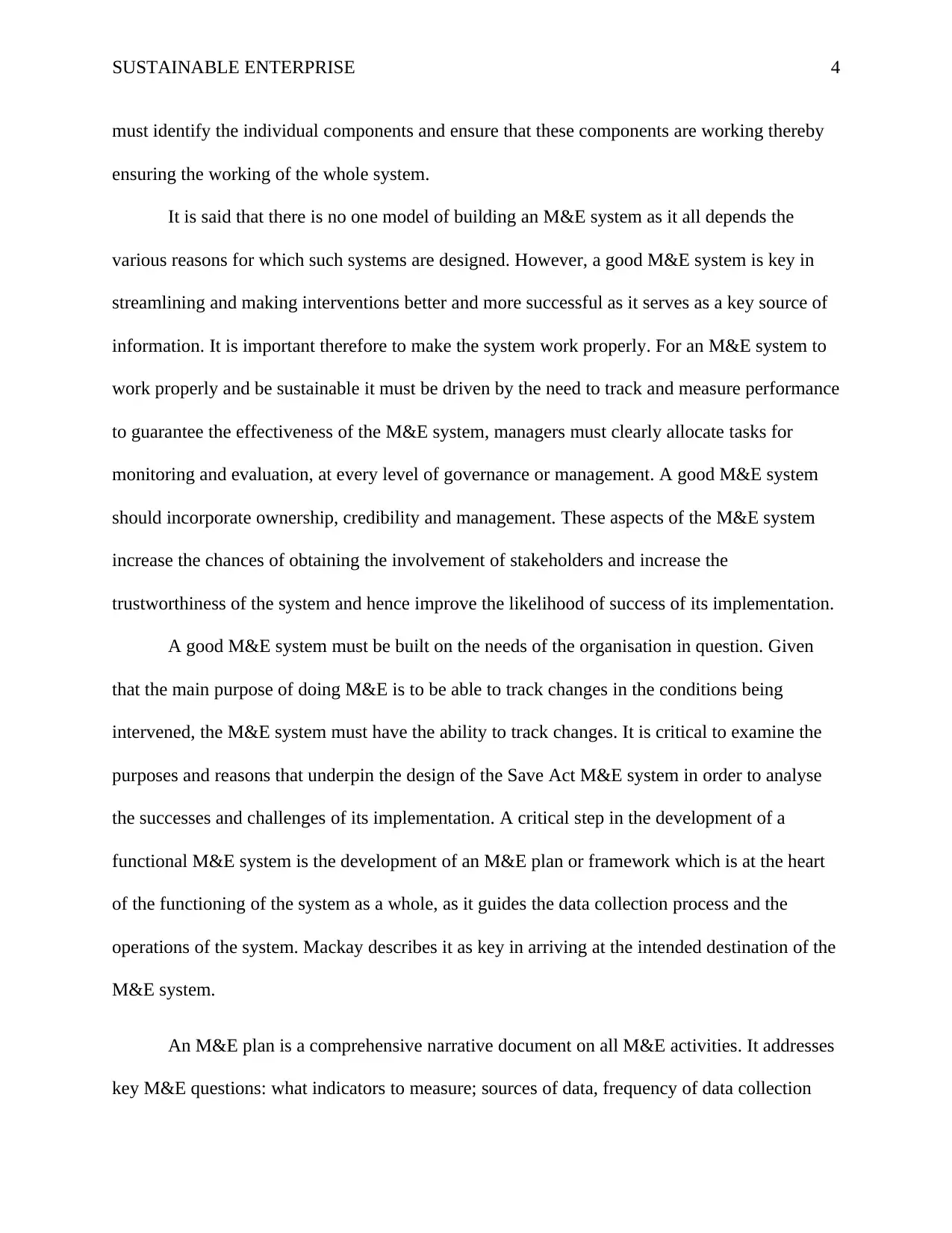
SUSTAINABLE ENTERPRISE 4
must identify the individual components and ensure that these components are working thereby
ensuring the working of the whole system.
It is said that there is no one model of building an M&E system as it all depends the
various reasons for which such systems are designed. However, a good M&E system is key in
streamlining and making interventions better and more successful as it serves as a key source of
information. It is important therefore to make the system work properly. For an M&E system to
work properly and be sustainable it must be driven by the need to track and measure performance
to guarantee the effectiveness of the M&E system, managers must clearly allocate tasks for
monitoring and evaluation, at every level of governance or management. A good M&E system
should incorporate ownership, credibility and management. These aspects of the M&E system
increase the chances of obtaining the involvement of stakeholders and increase the
trustworthiness of the system and hence improve the likelihood of success of its implementation.
A good M&E system must be built on the needs of the organisation in question. Given
that the main purpose of doing M&E is to be able to track changes in the conditions being
intervened, the M&E system must have the ability to track changes. It is critical to examine the
purposes and reasons that underpin the design of the Save Act M&E system in order to analyse
the successes and challenges of its implementation. A critical step in the development of a
functional M&E system is the development of an M&E plan or framework which is at the heart
of the functioning of the system as a whole, as it guides the data collection process and the
operations of the system. Mackay describes it as key in arriving at the intended destination of the
M&E system.
An M&E plan is a comprehensive narrative document on all M&E activities. It addresses
key M&E questions: what indicators to measure; sources of data, frequency of data collection
must identify the individual components and ensure that these components are working thereby
ensuring the working of the whole system.
It is said that there is no one model of building an M&E system as it all depends the
various reasons for which such systems are designed. However, a good M&E system is key in
streamlining and making interventions better and more successful as it serves as a key source of
information. It is important therefore to make the system work properly. For an M&E system to
work properly and be sustainable it must be driven by the need to track and measure performance
to guarantee the effectiveness of the M&E system, managers must clearly allocate tasks for
monitoring and evaluation, at every level of governance or management. A good M&E system
should incorporate ownership, credibility and management. These aspects of the M&E system
increase the chances of obtaining the involvement of stakeholders and increase the
trustworthiness of the system and hence improve the likelihood of success of its implementation.
A good M&E system must be built on the needs of the organisation in question. Given
that the main purpose of doing M&E is to be able to track changes in the conditions being
intervened, the M&E system must have the ability to track changes. It is critical to examine the
purposes and reasons that underpin the design of the Save Act M&E system in order to analyse
the successes and challenges of its implementation. A critical step in the development of a
functional M&E system is the development of an M&E plan or framework which is at the heart
of the functioning of the system as a whole, as it guides the data collection process and the
operations of the system. Mackay describes it as key in arriving at the intended destination of the
M&E system.
An M&E plan is a comprehensive narrative document on all M&E activities. It addresses
key M&E questions: what indicators to measure; sources of data, frequency of data collection
Paraphrase This Document
Need a fresh take? Get an instant paraphrase of this document with our AI Paraphraser
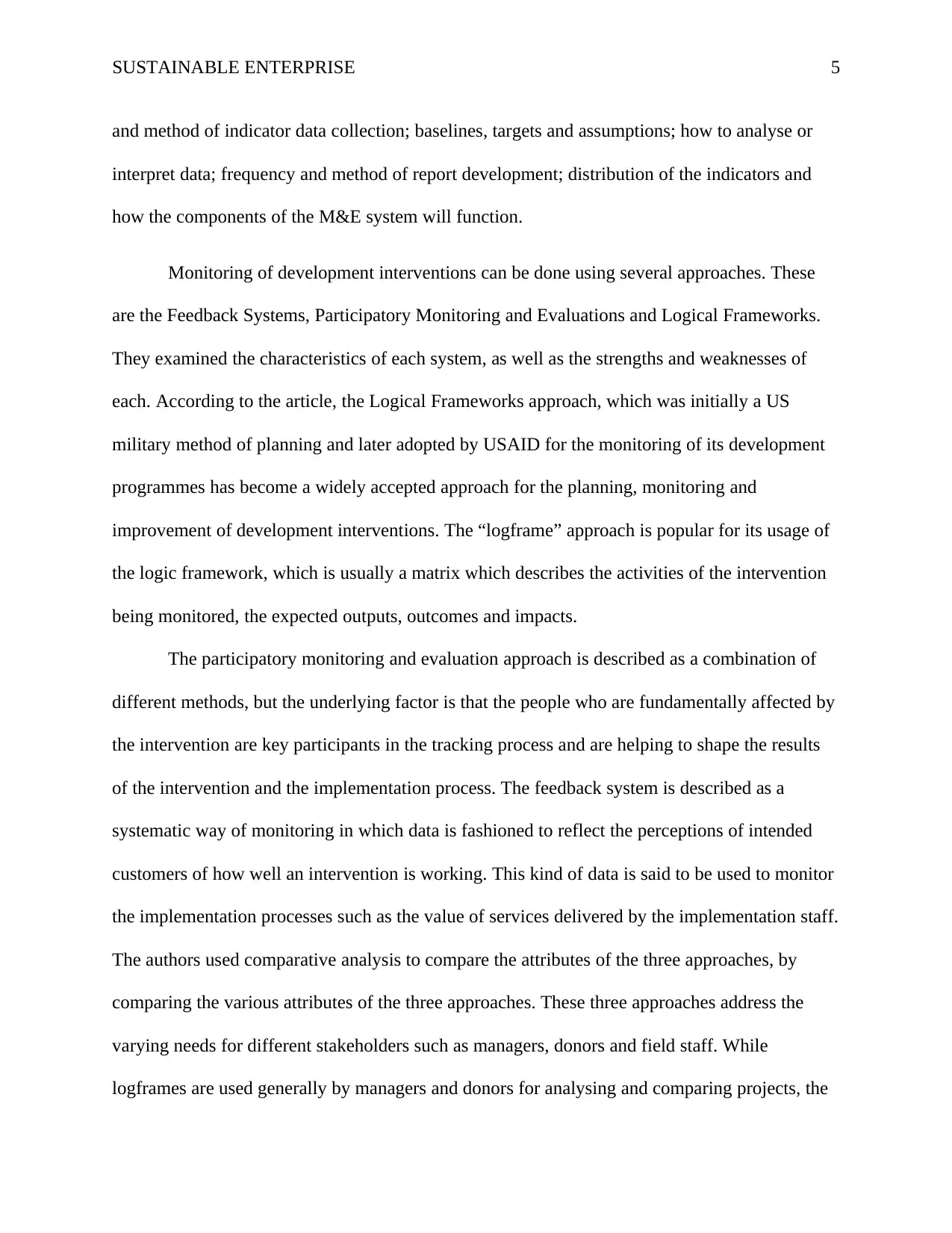
SUSTAINABLE ENTERPRISE 5
and method of indicator data collection; baselines, targets and assumptions; how to analyse or
interpret data; frequency and method of report development; distribution of the indicators and
how the components of the M&E system will function.
Monitoring of development interventions can be done using several approaches. These
are the Feedback Systems, Participatory Monitoring and Evaluations and Logical Frameworks.
They examined the characteristics of each system, as well as the strengths and weaknesses of
each. According to the article, the Logical Frameworks approach, which was initially a US
military method of planning and later adopted by USAID for the monitoring of its development
programmes has become a widely accepted approach for the planning, monitoring and
improvement of development interventions. The “logframe” approach is popular for its usage of
the logic framework, which is usually a matrix which describes the activities of the intervention
being monitored, the expected outputs, outcomes and impacts.
The participatory monitoring and evaluation approach is described as a combination of
different methods, but the underlying factor is that the people who are fundamentally affected by
the intervention are key participants in the tracking process and are helping to shape the results
of the intervention and the implementation process. The feedback system is described as a
systematic way of monitoring in which data is fashioned to reflect the perceptions of intended
customers of how well an intervention is working. This kind of data is said to be used to monitor
the implementation processes such as the value of services delivered by the implementation staff.
The authors used comparative analysis to compare the attributes of the three approaches, by
comparing the various attributes of the three approaches. These three approaches address the
varying needs for different stakeholders such as managers, donors and field staff. While
logframes are used generally by managers and donors for analysing and comparing projects, the
and method of indicator data collection; baselines, targets and assumptions; how to analyse or
interpret data; frequency and method of report development; distribution of the indicators and
how the components of the M&E system will function.
Monitoring of development interventions can be done using several approaches. These
are the Feedback Systems, Participatory Monitoring and Evaluations and Logical Frameworks.
They examined the characteristics of each system, as well as the strengths and weaknesses of
each. According to the article, the Logical Frameworks approach, which was initially a US
military method of planning and later adopted by USAID for the monitoring of its development
programmes has become a widely accepted approach for the planning, monitoring and
improvement of development interventions. The “logframe” approach is popular for its usage of
the logic framework, which is usually a matrix which describes the activities of the intervention
being monitored, the expected outputs, outcomes and impacts.
The participatory monitoring and evaluation approach is described as a combination of
different methods, but the underlying factor is that the people who are fundamentally affected by
the intervention are key participants in the tracking process and are helping to shape the results
of the intervention and the implementation process. The feedback system is described as a
systematic way of monitoring in which data is fashioned to reflect the perceptions of intended
customers of how well an intervention is working. This kind of data is said to be used to monitor
the implementation processes such as the value of services delivered by the implementation staff.
The authors used comparative analysis to compare the attributes of the three approaches, by
comparing the various attributes of the three approaches. These three approaches address the
varying needs for different stakeholders such as managers, donors and field staff. While
logframes are used generally by managers and donors for analysing and comparing projects, the
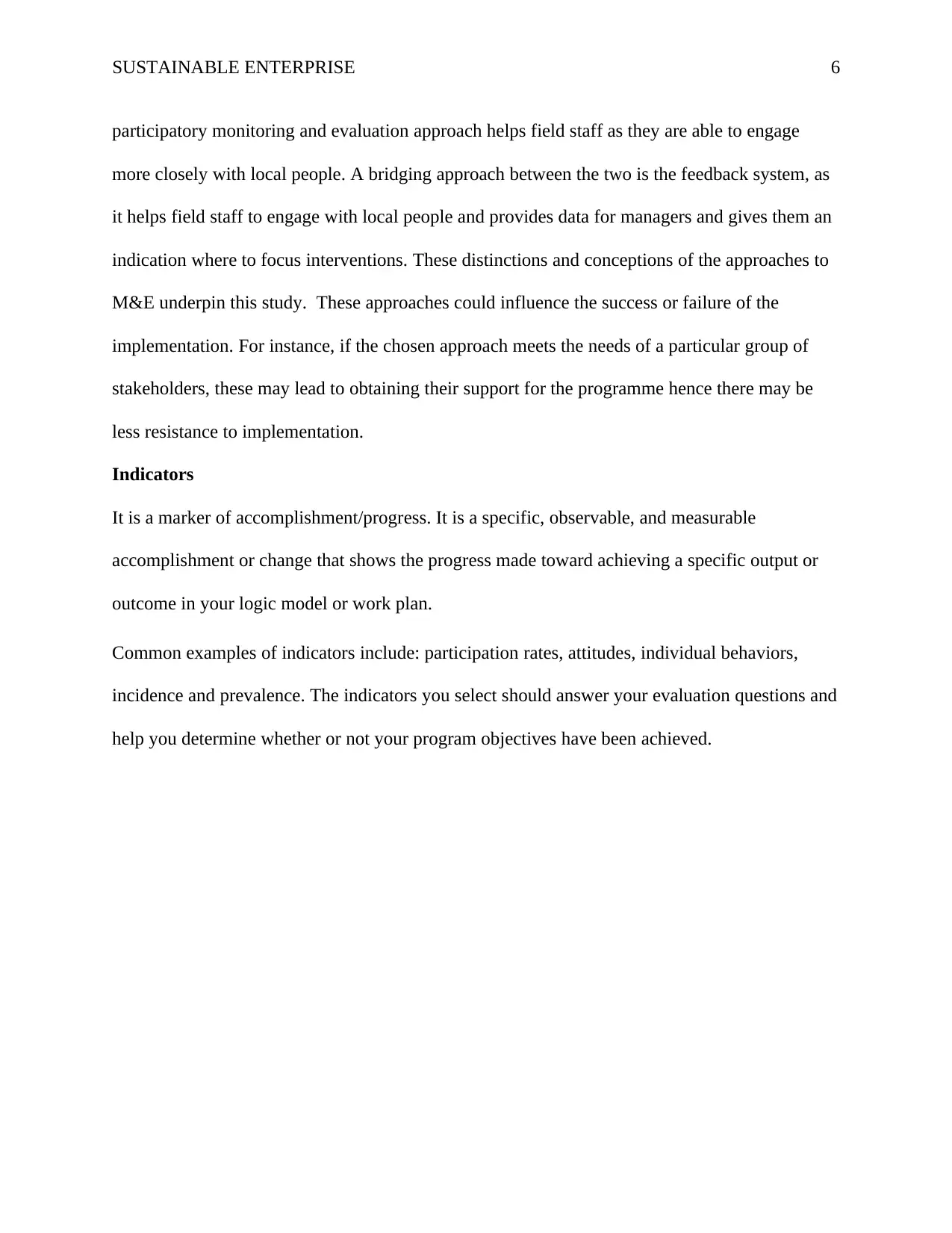
SUSTAINABLE ENTERPRISE 6
participatory monitoring and evaluation approach helps field staff as they are able to engage
more closely with local people. A bridging approach between the two is the feedback system, as
it helps field staff to engage with local people and provides data for managers and gives them an
indication where to focus interventions. These distinctions and conceptions of the approaches to
M&E underpin this study. These approaches could influence the success or failure of the
implementation. For instance, if the chosen approach meets the needs of a particular group of
stakeholders, these may lead to obtaining their support for the programme hence there may be
less resistance to implementation.
Indicators
It is a marker of accomplishment/progress. It is a specific, observable, and measurable
accomplishment or change that shows the progress made toward achieving a specific output or
outcome in your logic model or work plan.
Common examples of indicators include: participation rates, attitudes, individual behaviors,
incidence and prevalence. The indicators you select should answer your evaluation questions and
help you determine whether or not your program objectives have been achieved.
participatory monitoring and evaluation approach helps field staff as they are able to engage
more closely with local people. A bridging approach between the two is the feedback system, as
it helps field staff to engage with local people and provides data for managers and gives them an
indication where to focus interventions. These distinctions and conceptions of the approaches to
M&E underpin this study. These approaches could influence the success or failure of the
implementation. For instance, if the chosen approach meets the needs of a particular group of
stakeholders, these may lead to obtaining their support for the programme hence there may be
less resistance to implementation.
Indicators
It is a marker of accomplishment/progress. It is a specific, observable, and measurable
accomplishment or change that shows the progress made toward achieving a specific output or
outcome in your logic model or work plan.
Common examples of indicators include: participation rates, attitudes, individual behaviors,
incidence and prevalence. The indicators you select should answer your evaluation questions and
help you determine whether or not your program objectives have been achieved.
⊘ This is a preview!⊘
Do you want full access?
Subscribe today to unlock all pages.

Trusted by 1+ million students worldwide
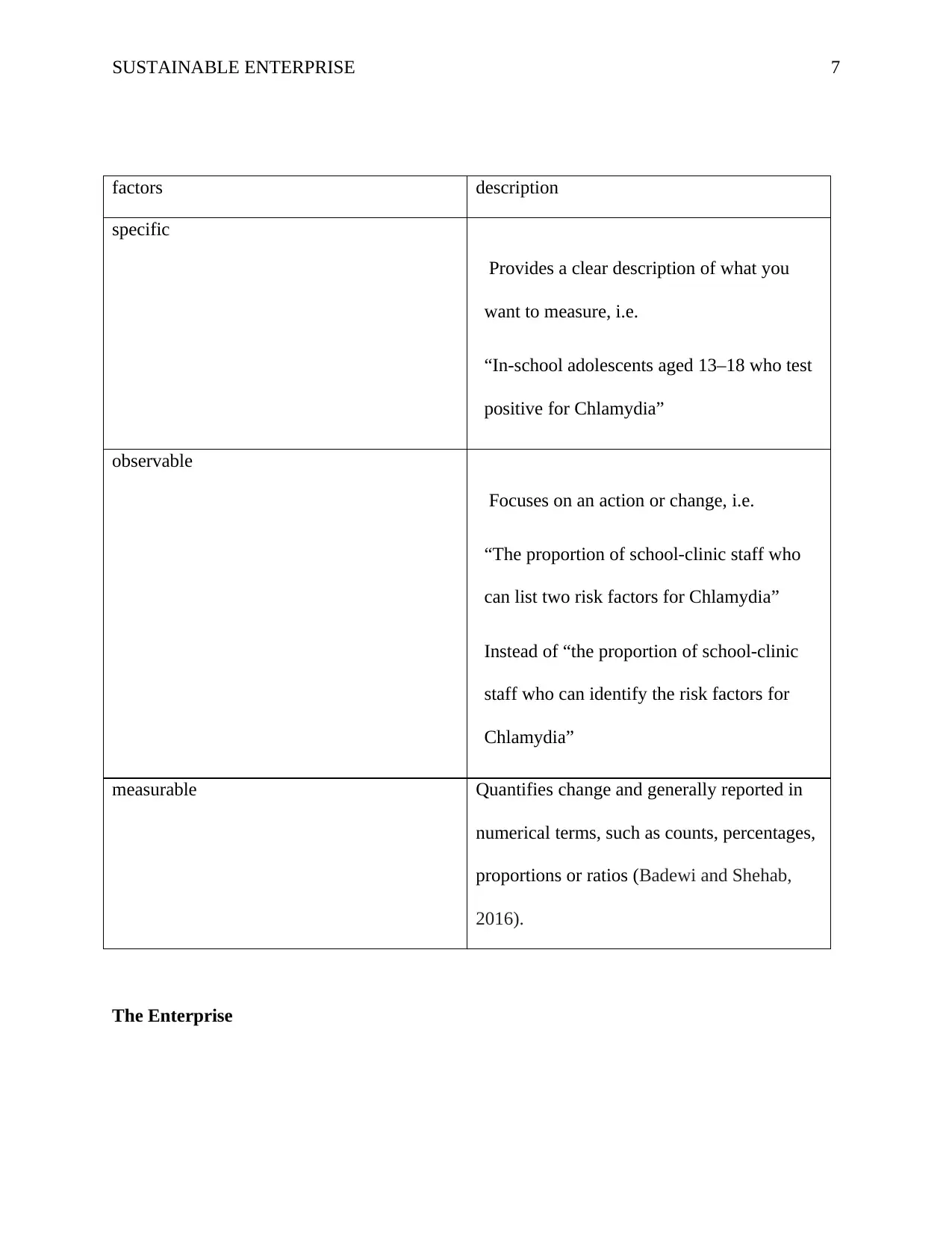
SUSTAINABLE ENTERPRISE 7
factors description
specific
Provides a clear description of what you
want to measure, i.e.
“In-school adolescents aged 13–18 who test
positive for Chlamydia”
observable
Focuses on an action or change, i.e.
“The proportion of school-clinic staff who
can list two risk factors for Chlamydia”
Instead of “the proportion of school-clinic
staff who can identify the risk factors for
Chlamydia”
measurable Quantifies change and generally reported in
numerical terms, such as counts, percentages,
proportions or ratios (Badewi and Shehab,
2016).
The Enterprise
factors description
specific
Provides a clear description of what you
want to measure, i.e.
“In-school adolescents aged 13–18 who test
positive for Chlamydia”
observable
Focuses on an action or change, i.e.
“The proportion of school-clinic staff who
can list two risk factors for Chlamydia”
Instead of “the proportion of school-clinic
staff who can identify the risk factors for
Chlamydia”
measurable Quantifies change and generally reported in
numerical terms, such as counts, percentages,
proportions or ratios (Badewi and Shehab,
2016).
The Enterprise
Paraphrase This Document
Need a fresh take? Get an instant paraphrase of this document with our AI Paraphraser
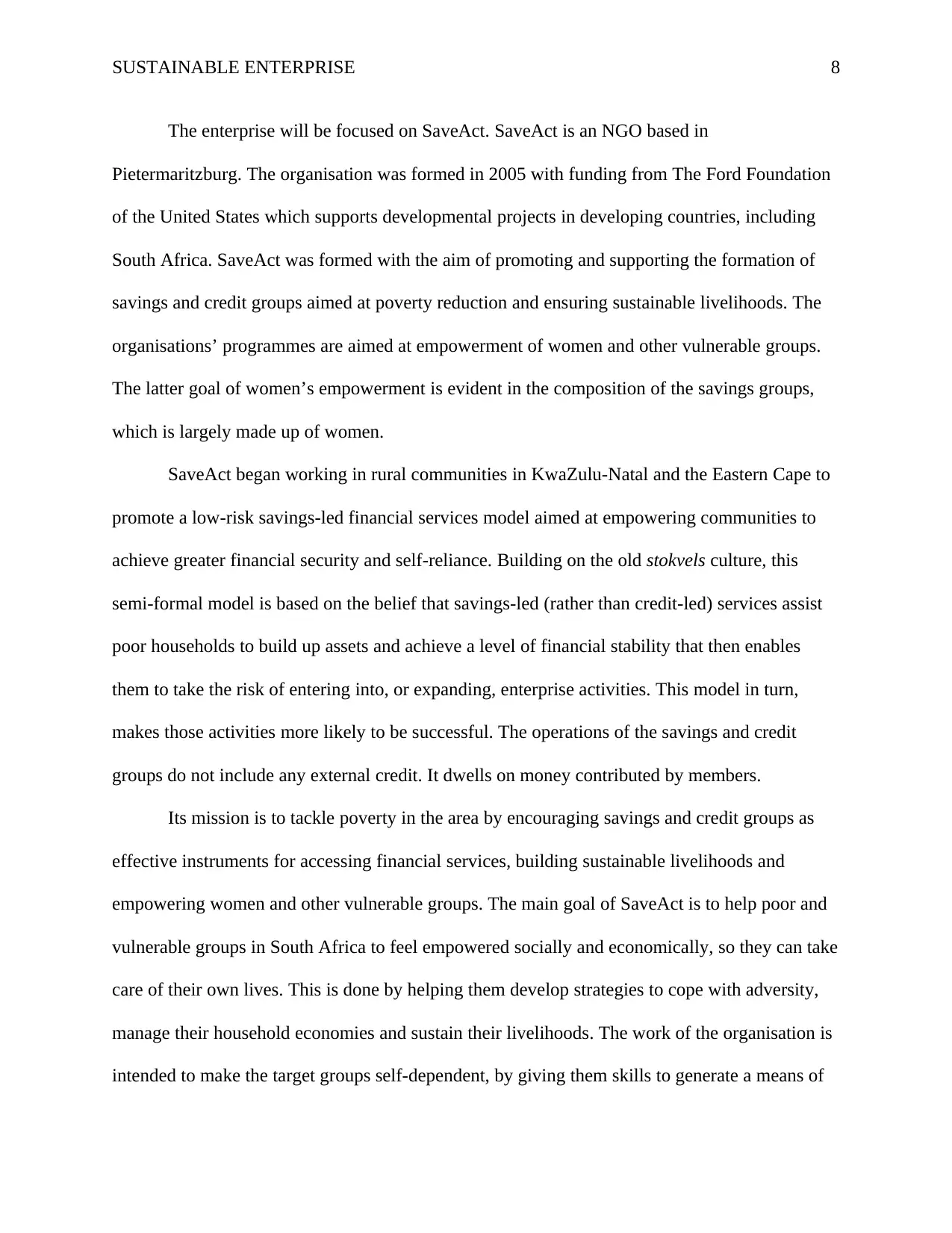
SUSTAINABLE ENTERPRISE 8
The enterprise will be focused on SaveAct. SaveAct is an NGO based in
Pietermaritzburg. The organisation was formed in 2005 with funding from The Ford Foundation
of the United States which supports developmental projects in developing countries, including
South Africa. SaveAct was formed with the aim of promoting and supporting the formation of
savings and credit groups aimed at poverty reduction and ensuring sustainable livelihoods. The
organisations’ programmes are aimed at empowerment of women and other vulnerable groups.
The latter goal of women’s empowerment is evident in the composition of the savings groups,
which is largely made up of women.
SaveAct began working in rural communities in KwaZulu-Natal and the Eastern Cape to
promote a low-risk savings-led financial services model aimed at empowering communities to
achieve greater financial security and self-reliance. Building on the old stokvels culture, this
semi-formal model is based on the belief that savings-led (rather than credit-led) services assist
poor households to build up assets and achieve a level of financial stability that then enables
them to take the risk of entering into, or expanding, enterprise activities. This model in turn,
makes those activities more likely to be successful. The operations of the savings and credit
groups do not include any external credit. It dwells on money contributed by members.
Its mission is to tackle poverty in the area by encouraging savings and credit groups as
effective instruments for accessing financial services, building sustainable livelihoods and
empowering women and other vulnerable groups. The main goal of SaveAct is to help poor and
vulnerable groups in South Africa to feel empowered socially and economically, so they can take
care of their own lives. This is done by helping them develop strategies to cope with adversity,
manage their household economies and sustain their livelihoods. The work of the organisation is
intended to make the target groups self-dependent, by giving them skills to generate a means of
The enterprise will be focused on SaveAct. SaveAct is an NGO based in
Pietermaritzburg. The organisation was formed in 2005 with funding from The Ford Foundation
of the United States which supports developmental projects in developing countries, including
South Africa. SaveAct was formed with the aim of promoting and supporting the formation of
savings and credit groups aimed at poverty reduction and ensuring sustainable livelihoods. The
organisations’ programmes are aimed at empowerment of women and other vulnerable groups.
The latter goal of women’s empowerment is evident in the composition of the savings groups,
which is largely made up of women.
SaveAct began working in rural communities in KwaZulu-Natal and the Eastern Cape to
promote a low-risk savings-led financial services model aimed at empowering communities to
achieve greater financial security and self-reliance. Building on the old stokvels culture, this
semi-formal model is based on the belief that savings-led (rather than credit-led) services assist
poor households to build up assets and achieve a level of financial stability that then enables
them to take the risk of entering into, or expanding, enterprise activities. This model in turn,
makes those activities more likely to be successful. The operations of the savings and credit
groups do not include any external credit. It dwells on money contributed by members.
Its mission is to tackle poverty in the area by encouraging savings and credit groups as
effective instruments for accessing financial services, building sustainable livelihoods and
empowering women and other vulnerable groups. The main goal of SaveAct is to help poor and
vulnerable groups in South Africa to feel empowered socially and economically, so they can take
care of their own lives. This is done by helping them develop strategies to cope with adversity,
manage their household economies and sustain their livelihoods. The work of the organisation is
intended to make the target groups self-dependent, by giving them skills to generate a means of
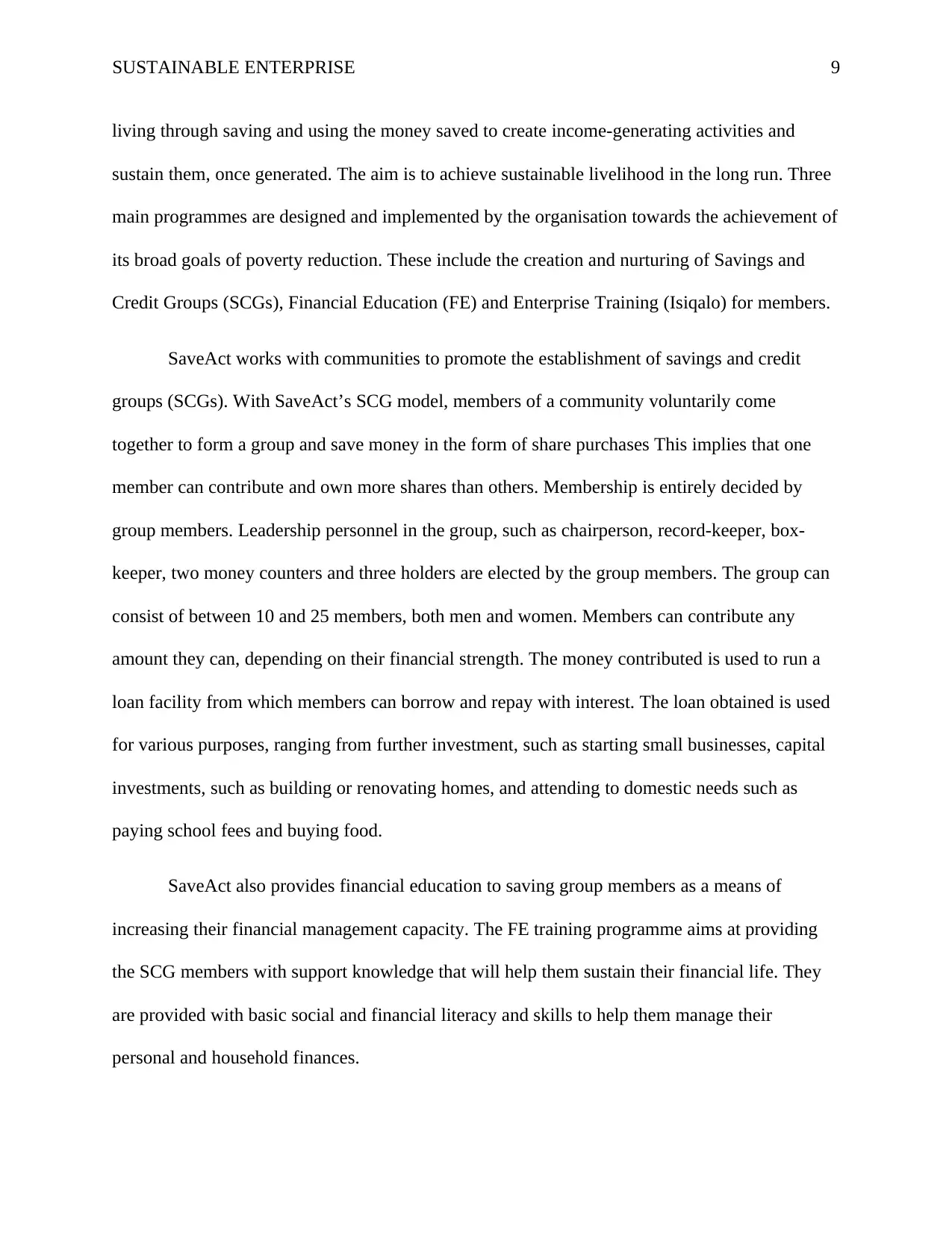
SUSTAINABLE ENTERPRISE 9
living through saving and using the money saved to create income-generating activities and
sustain them, once generated. The aim is to achieve sustainable livelihood in the long run. Three
main programmes are designed and implemented by the organisation towards the achievement of
its broad goals of poverty reduction. These include the creation and nurturing of Savings and
Credit Groups (SCGs), Financial Education (FE) and Enterprise Training (Isiqalo) for members.
SaveAct works with communities to promote the establishment of savings and credit
groups (SCGs). With SaveAct’s SCG model, members of a community voluntarily come
together to form a group and save money in the form of share purchases This implies that one
member can contribute and own more shares than others. Membership is entirely decided by
group members. Leadership personnel in the group, such as chairperson, record-keeper, box-
keeper, two money counters and three holders are elected by the group members. The group can
consist of between 10 and 25 members, both men and women. Members can contribute any
amount they can, depending on their financial strength. The money contributed is used to run a
loan facility from which members can borrow and repay with interest. The loan obtained is used
for various purposes, ranging from further investment, such as starting small businesses, capital
investments, such as building or renovating homes, and attending to domestic needs such as
paying school fees and buying food.
SaveAct also provides financial education to saving group members as a means of
increasing their financial management capacity. The FE training programme aims at providing
the SCG members with support knowledge that will help them sustain their financial life. They
are provided with basic social and financial literacy and skills to help them manage their
personal and household finances.
living through saving and using the money saved to create income-generating activities and
sustain them, once generated. The aim is to achieve sustainable livelihood in the long run. Three
main programmes are designed and implemented by the organisation towards the achievement of
its broad goals of poverty reduction. These include the creation and nurturing of Savings and
Credit Groups (SCGs), Financial Education (FE) and Enterprise Training (Isiqalo) for members.
SaveAct works with communities to promote the establishment of savings and credit
groups (SCGs). With SaveAct’s SCG model, members of a community voluntarily come
together to form a group and save money in the form of share purchases This implies that one
member can contribute and own more shares than others. Membership is entirely decided by
group members. Leadership personnel in the group, such as chairperson, record-keeper, box-
keeper, two money counters and three holders are elected by the group members. The group can
consist of between 10 and 25 members, both men and women. Members can contribute any
amount they can, depending on their financial strength. The money contributed is used to run a
loan facility from which members can borrow and repay with interest. The loan obtained is used
for various purposes, ranging from further investment, such as starting small businesses, capital
investments, such as building or renovating homes, and attending to domestic needs such as
paying school fees and buying food.
SaveAct also provides financial education to saving group members as a means of
increasing their financial management capacity. The FE training programme aims at providing
the SCG members with support knowledge that will help them sustain their financial life. They
are provided with basic social and financial literacy and skills to help them manage their
personal and household finances.
⊘ This is a preview!⊘
Do you want full access?
Subscribe today to unlock all pages.

Trusted by 1+ million students worldwide
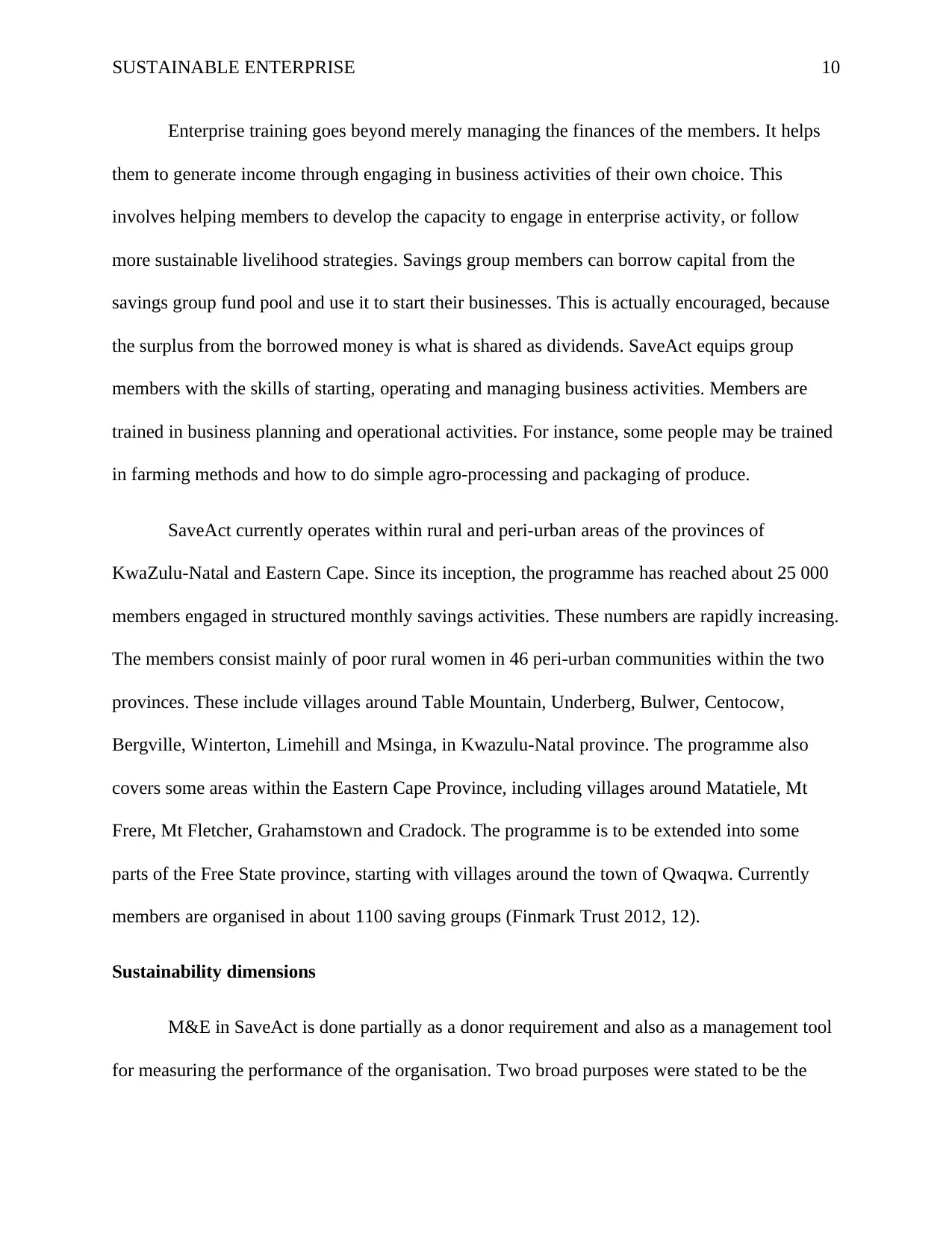
SUSTAINABLE ENTERPRISE 10
Enterprise training goes beyond merely managing the finances of the members. It helps
them to generate income through engaging in business activities of their own choice. This
involves helping members to develop the capacity to engage in enterprise activity, or follow
more sustainable livelihood strategies. Savings group members can borrow capital from the
savings group fund pool and use it to start their businesses. This is actually encouraged, because
the surplus from the borrowed money is what is shared as dividends. SaveAct equips group
members with the skills of starting, operating and managing business activities. Members are
trained in business planning and operational activities. For instance, some people may be trained
in farming methods and how to do simple agro-processing and packaging of produce.
SaveAct currently operates within rural and peri-urban areas of the provinces of
KwaZulu-Natal and Eastern Cape. Since its inception, the programme has reached about 25 000
members engaged in structured monthly savings activities. These numbers are rapidly increasing.
The members consist mainly of poor rural women in 46 peri-urban communities within the two
provinces. These include villages around Table Mountain, Underberg, Bulwer, Centocow,
Bergville, Winterton, Limehill and Msinga, in Kwazulu-Natal province. The programme also
covers some areas within the Eastern Cape Province, including villages around Matatiele, Mt
Frere, Mt Fletcher, Grahamstown and Cradock. The programme is to be extended into some
parts of the Free State province, starting with villages around the town of Qwaqwa. Currently
members are organised in about 1100 saving groups (Finmark Trust 2012, 12).
Sustainability dimensions
M&E in SaveAct is done partially as a donor requirement and also as a management tool
for measuring the performance of the organisation. Two broad purposes were stated to be the
Enterprise training goes beyond merely managing the finances of the members. It helps
them to generate income through engaging in business activities of their own choice. This
involves helping members to develop the capacity to engage in enterprise activity, or follow
more sustainable livelihood strategies. Savings group members can borrow capital from the
savings group fund pool and use it to start their businesses. This is actually encouraged, because
the surplus from the borrowed money is what is shared as dividends. SaveAct equips group
members with the skills of starting, operating and managing business activities. Members are
trained in business planning and operational activities. For instance, some people may be trained
in farming methods and how to do simple agro-processing and packaging of produce.
SaveAct currently operates within rural and peri-urban areas of the provinces of
KwaZulu-Natal and Eastern Cape. Since its inception, the programme has reached about 25 000
members engaged in structured monthly savings activities. These numbers are rapidly increasing.
The members consist mainly of poor rural women in 46 peri-urban communities within the two
provinces. These include villages around Table Mountain, Underberg, Bulwer, Centocow,
Bergville, Winterton, Limehill and Msinga, in Kwazulu-Natal province. The programme also
covers some areas within the Eastern Cape Province, including villages around Matatiele, Mt
Frere, Mt Fletcher, Grahamstown and Cradock. The programme is to be extended into some
parts of the Free State province, starting with villages around the town of Qwaqwa. Currently
members are organised in about 1100 saving groups (Finmark Trust 2012, 12).
Sustainability dimensions
M&E in SaveAct is done partially as a donor requirement and also as a management tool
for measuring the performance of the organisation. Two broad purposes were stated to be the
Paraphrase This Document
Need a fresh take? Get an instant paraphrase of this document with our AI Paraphraser
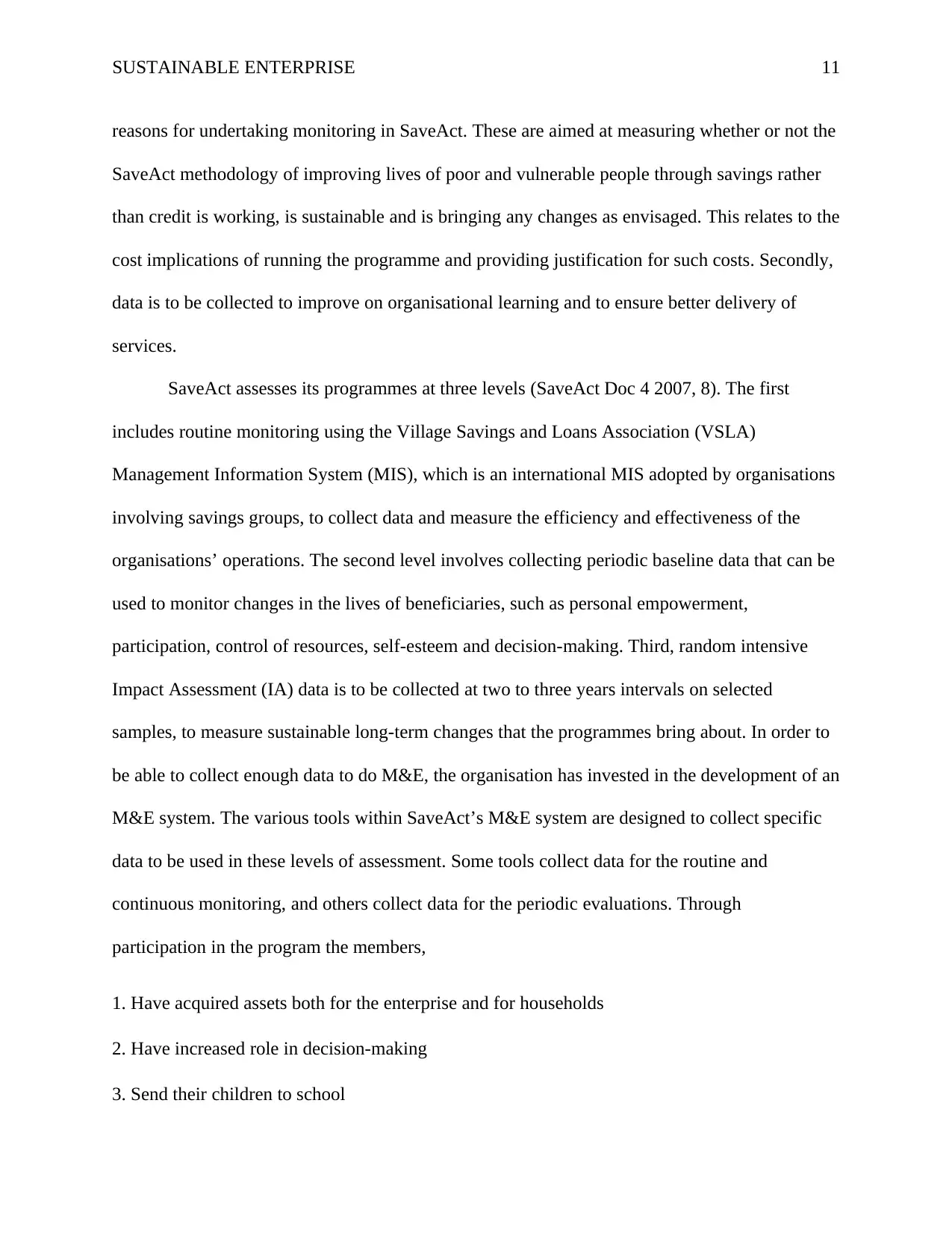
SUSTAINABLE ENTERPRISE 11
reasons for undertaking monitoring in SaveAct. These are aimed at measuring whether or not the
SaveAct methodology of improving lives of poor and vulnerable people through savings rather
than credit is working, is sustainable and is bringing any changes as envisaged. This relates to the
cost implications of running the programme and providing justification for such costs. Secondly,
data is to be collected to improve on organisational learning and to ensure better delivery of
services.
SaveAct assesses its programmes at three levels (SaveAct Doc 4 2007, 8). The first
includes routine monitoring using the Village Savings and Loans Association (VSLA)
Management Information System (MIS), which is an international MIS adopted by organisations
involving savings groups, to collect data and measure the efficiency and effectiveness of the
organisations’ operations. The second level involves collecting periodic baseline data that can be
used to monitor changes in the lives of beneficiaries, such as personal empowerment,
participation, control of resources, self-esteem and decision-making. Third, random intensive
Impact Assessment (IA) data is to be collected at two to three years intervals on selected
samples, to measure sustainable long-term changes that the programmes bring about. In order to
be able to collect enough data to do M&E, the organisation has invested in the development of an
M&E system. The various tools within SaveAct’s M&E system are designed to collect specific
data to be used in these levels of assessment. Some tools collect data for the routine and
continuous monitoring, and others collect data for the periodic evaluations. Through
participation in the program the members,
1. Have acquired assets both for the enterprise and for households
2. Have increased role in decision-making
3. Send their children to school
reasons for undertaking monitoring in SaveAct. These are aimed at measuring whether or not the
SaveAct methodology of improving lives of poor and vulnerable people through savings rather
than credit is working, is sustainable and is bringing any changes as envisaged. This relates to the
cost implications of running the programme and providing justification for such costs. Secondly,
data is to be collected to improve on organisational learning and to ensure better delivery of
services.
SaveAct assesses its programmes at three levels (SaveAct Doc 4 2007, 8). The first
includes routine monitoring using the Village Savings and Loans Association (VSLA)
Management Information System (MIS), which is an international MIS adopted by organisations
involving savings groups, to collect data and measure the efficiency and effectiveness of the
organisations’ operations. The second level involves collecting periodic baseline data that can be
used to monitor changes in the lives of beneficiaries, such as personal empowerment,
participation, control of resources, self-esteem and decision-making. Third, random intensive
Impact Assessment (IA) data is to be collected at two to three years intervals on selected
samples, to measure sustainable long-term changes that the programmes bring about. In order to
be able to collect enough data to do M&E, the organisation has invested in the development of an
M&E system. The various tools within SaveAct’s M&E system are designed to collect specific
data to be used in these levels of assessment. Some tools collect data for the routine and
continuous monitoring, and others collect data for the periodic evaluations. Through
participation in the program the members,
1. Have acquired assets both for the enterprise and for households
2. Have increased role in decision-making
3. Send their children to school
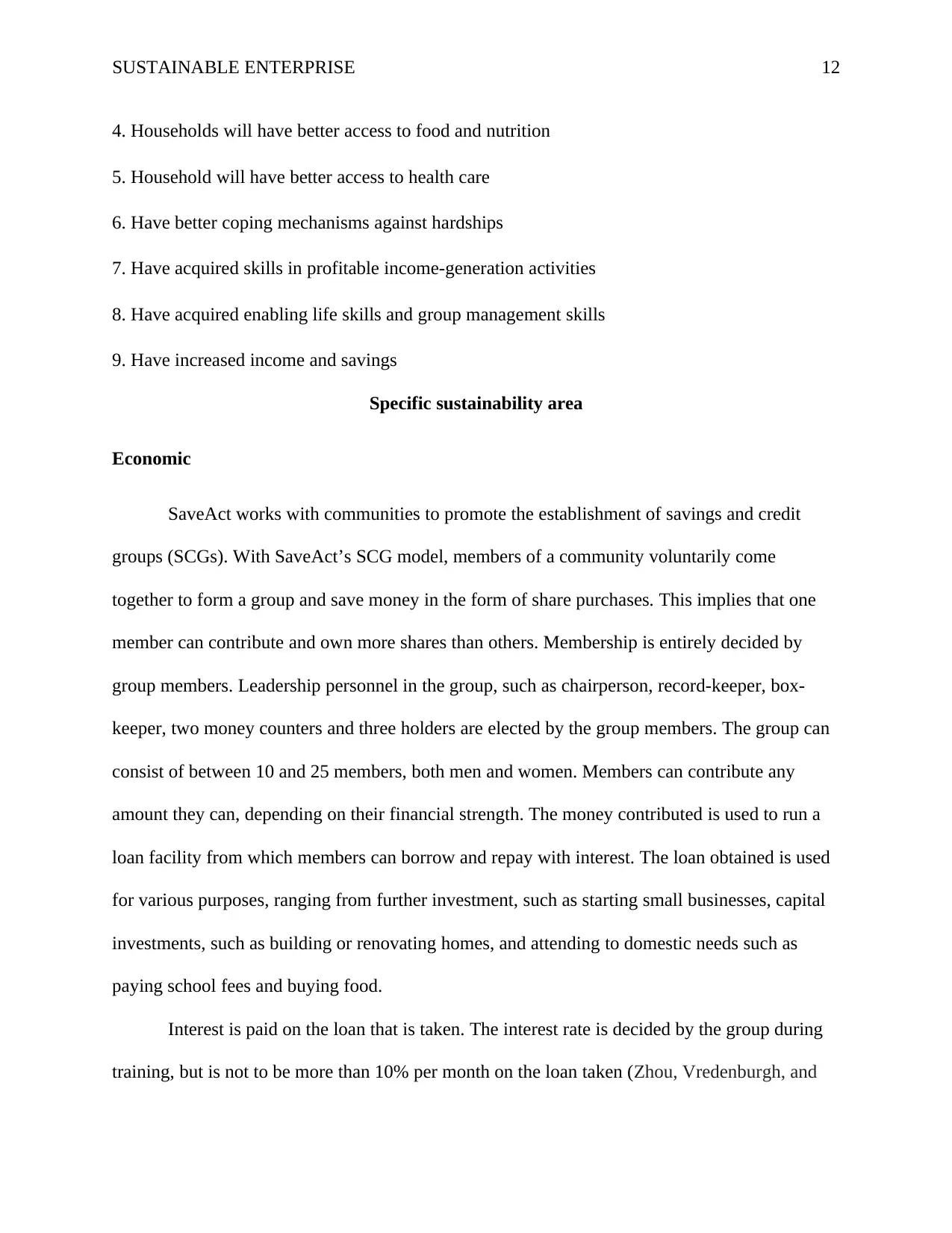
SUSTAINABLE ENTERPRISE 12
4. Households will have better access to food and nutrition
5. Household will have better access to health care
6. Have better coping mechanisms against hardships
7. Have acquired skills in profitable income-generation activities
8. Have acquired enabling life skills and group management skills
9. Have increased income and savings
Specific sustainability area
Economic
SaveAct works with communities to promote the establishment of savings and credit
groups (SCGs). With SaveAct’s SCG model, members of a community voluntarily come
together to form a group and save money in the form of share purchases. This implies that one
member can contribute and own more shares than others. Membership is entirely decided by
group members. Leadership personnel in the group, such as chairperson, record-keeper, box-
keeper, two money counters and three holders are elected by the group members. The group can
consist of between 10 and 25 members, both men and women. Members can contribute any
amount they can, depending on their financial strength. The money contributed is used to run a
loan facility from which members can borrow and repay with interest. The loan obtained is used
for various purposes, ranging from further investment, such as starting small businesses, capital
investments, such as building or renovating homes, and attending to domestic needs such as
paying school fees and buying food.
Interest is paid on the loan that is taken. The interest rate is decided by the group during
training, but is not to be more than 10% per month on the loan taken (Zhou, Vredenburgh, and
4. Households will have better access to food and nutrition
5. Household will have better access to health care
6. Have better coping mechanisms against hardships
7. Have acquired skills in profitable income-generation activities
8. Have acquired enabling life skills and group management skills
9. Have increased income and savings
Specific sustainability area
Economic
SaveAct works with communities to promote the establishment of savings and credit
groups (SCGs). With SaveAct’s SCG model, members of a community voluntarily come
together to form a group and save money in the form of share purchases. This implies that one
member can contribute and own more shares than others. Membership is entirely decided by
group members. Leadership personnel in the group, such as chairperson, record-keeper, box-
keeper, two money counters and three holders are elected by the group members. The group can
consist of between 10 and 25 members, both men and women. Members can contribute any
amount they can, depending on their financial strength. The money contributed is used to run a
loan facility from which members can borrow and repay with interest. The loan obtained is used
for various purposes, ranging from further investment, such as starting small businesses, capital
investments, such as building or renovating homes, and attending to domestic needs such as
paying school fees and buying food.
Interest is paid on the loan that is taken. The interest rate is decided by the group during
training, but is not to be more than 10% per month on the loan taken (Zhou, Vredenburgh, and
⊘ This is a preview!⊘
Do you want full access?
Subscribe today to unlock all pages.

Trusted by 1+ million students worldwide
1 out of 19
Related Documents
Your All-in-One AI-Powered Toolkit for Academic Success.
+13062052269
info@desklib.com
Available 24*7 on WhatsApp / Email
![[object Object]](/_next/static/media/star-bottom.7253800d.svg)
Unlock your academic potential
Copyright © 2020–2025 A2Z Services. All Rights Reserved. Developed and managed by ZUCOL.





